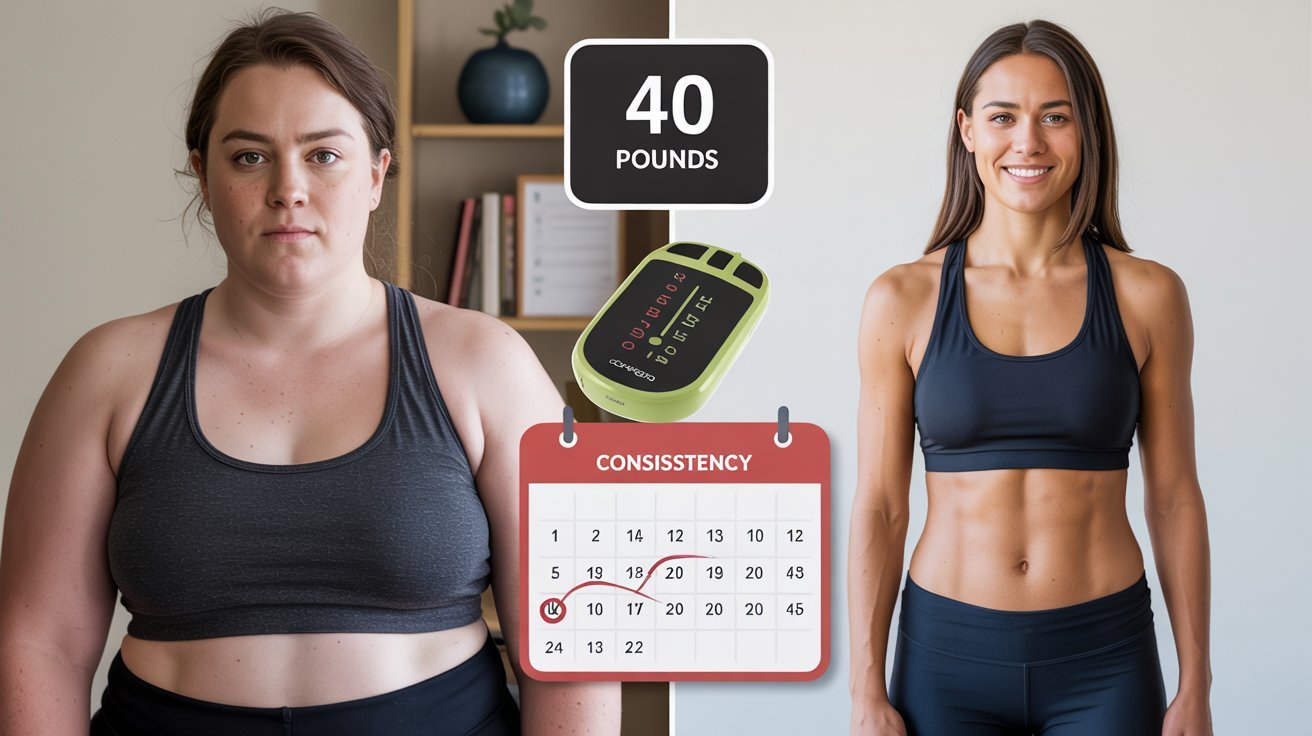Losing 40 pounds in just two months may sound challenging. But with the right plan and commitment, it’s possible to achieve.
Weight loss isn’t just about cutting calories; it’s about creating a sustainable routine. Proper nutrition, regular exercise, and small lifestyle changes can make a big difference. Quick results require focus, discipline, and consistency. While the journey may seem tough, the rewards are worth it.
Imagine feeling healthier, more confident, and full of energy in just eight weeks. This guide will walk you through practical steps to reach your goal. From meal planning to effective workouts, each tip is designed to help you succeed. Ready to transform your body and mindset? Let’s dive into the strategies that will help you lose 40 pounds in just two months.

Setting Realistic Goals
Losing 40 pounds in two months is a significant challenge. Success starts with setting goals that are both inspiring and attainable. The journey to weight loss can be overwhelming. Realistic goals create a roadmap to success. They turn a distant dream into a series of achievable steps. Let’s delve into how careful planning and breaking down your weight loss target can help you succeed.
Importance Of Planning
Planning is your foundation. Without it, goals are just wishes. A good plan guides you through each day. It tells you what to eat, when to exercise, and how to stay motivated. It keeps you on track, so you don’t lose sight of your target. Think of your plan as a daily checklist for losing weight.
Breaking Down The Weight Loss Target
Forty pounds in two months means losing five pounds a week. That’s a big goal. Break it down into smaller, daily goals. Aim to lose a little bit each day. This makes the task less daunting. Small wins every day add up to big results. Remember, it’s not just about the scale. Celebrate every healthy choice and every workout completed.

Building A Calorie Deficit
If you want to lose 40 pounds in two months, creating a calorie deficit is non-negotiable. A calorie deficit means eating fewer calories than your body burns each day. This drives weight loss by forcing your body to tap into stored fat for energy.
But here’s the tricky part—how do you actually make this happen? Let’s break it down step by step.
Tracking Daily Calorie Intake
Start by figuring out how many calories you consume daily. You can use apps like MyFitnessPal or Cronometer to keep track. These tools make it easy to log meals and snacks.
Be honest when tracking. A handful of chips or a splash of creamer in your coffee adds up. Accuracy will help you pinpoint areas where you can cut back.
Ask yourself: Are you eating out of hunger or habit? Identifying mindless eating patterns can help you avoid unnecessary calories. Keep a food diary for a week—it may surprise you!
Choosing Low-calorie, Nutrient-dense Foods
Swap calorie-heavy foods for nutrient-rich options that keep you full longer. For example, replace a bag of chips with air-popped popcorn or a candy bar with a handful of mixed nuts.
Fill your plate with vegetables like spinach, broccoli, and zucchini. These are low in calories but packed with fiber and vitamins. A large salad with a light vinaigrette dressing can be a satisfying meal.
Craving something sweet? Choose fruits like berries or an apple instead of sugary desserts. They satisfy your sweet tooth without overloading your calorie count.
What changes can you make today to improve your calorie balance? Small shifts in your food choices can lead to big results over time.
Designing An Exercise Plan
Creating an effective exercise plan is essential if you want to lose 40 pounds in 2 months. It’s not just about burning calories; it’s about building habits that set you up for long-term success. The right combination of cardio and strength training can make all the difference in hitting your weight-loss goals.
Incorporating Cardio Workouts
Cardio is a powerful tool for burning calories quickly. Aim for 30 to 60 minutes of cardio at least five days a week. Activities like running, cycling, or brisk walking can help you torch fat and improve your endurance.
Mix it up to keep things interesting. Try alternating between steady-state cardio (like jogging at a consistent pace) and high-intensity interval training (HIIT). For example, you could sprint for 30 seconds, then walk for 1 minute, repeating this cycle for 20 minutes. This keeps your metabolism revved up even after your workout ends.
Not a fan of running? Consider dance workouts, swimming, or even jumping rope. The key is to pick something you enjoy, so you’ll stick with it. Which activity will you commit to this week?
Strength Training For Fat Loss
Don’t underestimate the power of strength training. Building muscle increases your resting metabolism, which means you’ll burn more calories even when you’re not exercising. Start with two to three sessions a week, focusing on compound movements like squats, deadlifts, and push-ups.
If you’re new to weights, bodyweight exercises can be just as effective. For instance, try doing 3 sets of 10 squats, lunges, and planks. Gradually add more reps or resistance as you get stronger.
Strength training also helps prevent muscle loss while you’re shedding fat. Without it, you risk losing muscle along with fat, which can slow your progress. How will you challenge your muscles today?
Combining cardio with strength training creates a balanced plan that maximizes fat loss while improving your overall fitness. It’s not about doing more—it’s about working smarter. Are you ready to start designing your plan?
Optimizing Meal Prep
Meal prep can make or break your weight loss journey. When you’re aiming to lose 40 pounds in 2 months, every meal matters. By optimizing your meal prep, you can save time, avoid poor food choices, and stay on track with your calorie goals.
Batch Cooking Healthy Meals
Cooking meals in bulk is a game-changer for staying consistent. Instead of deciding what to eat every day, you’ll already have healthy, portion-controlled options ready to go. This reduces the temptation to grab fast food or snacks when you’re hungry.
Start by picking 2-3 lean proteins like chicken breast, turkey, or tofu. Pair these with versatile vegetables such as broccoli, spinach, and bell peppers. Cook them all at once and store them in airtight containers for the week.
Make it even easier by using a slow cooker or an instant pot to prepare large batches of soups, stews, or chili. Add spices like garlic, paprika, or cumin to keep things flavorful. Wouldn’t it feel great to open your fridge and see a week’s worth of healthy meals waiting for you?
Avoiding Hidden Calorie Traps
Not all “healthy” foods are created equal. Sometimes, the extras you add to your meals can quietly sabotage your progress. Are you keeping an eye on sauces, dressings, or oils?
Stick to light options like lemon juice or balsamic vinegar for dressings. Measure your cooking oil instead of eyeballing it—it’s easy to use more than you realize. A tablespoon of olive oil has 120 calories, and those extra spoonfuls can add up fast!
Also, watch out for pre-packaged “healthy snacks” like granola bars. Many are loaded with sugar and unnecessary calories. Instead, try prepping your own snacks, like boiled eggs, cut-up veggies, or a handful of almonds.
When you take control of your meal prep, you take control of your progress. What small changes can you make to your next grocery list to set yourself up for success?
Staying Hydrated
If you’re trying to lose 40 pounds in 2 months, staying hydrated is not just important—it’s essential. Water plays a key role in weight loss by boosting your metabolism, keeping hunger in check, and improving overall health. Let’s dive into why hydration matters and how you can make smarter beverage choices.
Benefits Of Drinking Water
Drinking enough water can help your body burn calories more efficiently. Studies suggest that drinking water before meals may reduce your appetite, leading you to eat less.
Water also helps flush out toxins that might slow down your weight loss progress. Staying hydrated keeps your digestion running smoothly, which is crucial when you’re trying to drop pounds fast.
Think about this: drinking cold water can temporarily boost your metabolism, as your body works harder to warm it up. Why not add a few icy glasses to your daily routine?
Reducing Sugary Beverage Consumption
Sugary drinks like soda, juice, and energy drinks can sabotage your weight loss journey. They’re packed with empty calories that won’t keep you full but will add to your daily intake.
Instead, reach for water, herbal teas, or infused water with slices of lemon or cucumber. These options are refreshing and won’t derail your progress.
Ask yourself: how many sugary drinks are you consuming each week? Cutting them out entirely or swapping them for healthier alternatives can make a big difference. Try tracking your beverage choices for a few days—it’s eye-opening!
Managing Stress And Sleep
Losing 40 pounds in two months is a challenge that requires more than diet and exercise. Managing stress and getting enough sleep are key to success. Let’s explore these often-overlooked factors in weight loss.
Impact Of Stress On Weight Loss
Stress triggers your body to release cortisol. This hormone can lead to weight gain, especially around your belly. High stress levels make losing weight harder. It’s important to find ways to relax. Deep breathing, meditation, and walking can all help reduce stress.
Prioritizing Quality Sleep
Sleep is crucial for weight loss. A rested body can burn fat more effectively. Aim for 7-9 hours of sleep each night. Keep your bedroom cool and dark. Stick to a sleep schedule. Good sleep helps your body and mind. It keeps you focused and energized for your weight loss journey.
Monitoring Progress
Tracking your weight loss journey is key to staying motivated. It helps you identify what’s working and where adjustments are needed. Monitoring your progress keeps you focused and aware of your achievements along the way.
Consistency is important, and keeping track helps you maintain it. This section explores simple ways to monitor your progress effectively.
Using A Weight Loss Journal
A weight loss journal is a powerful tool. Write down your daily meals, workouts, and weight changes. It allows you to spot patterns and make smarter choices.
Record your feelings and energy levels too. This helps you understand how your body reacts to different foods and activities. You can use a notebook or a digital app for convenience.
Review your journal weekly to see your progress. This builds confidence and keeps you motivated. It’s also useful for identifying habits that slow your progress.
Celebrating Small Milestones
Small victories matter in your weight loss journey. Celebrate every 5-pound drop or sticking to your meal plan for a week. These milestones boost your morale and encourage consistency.
Reward yourself in healthy ways. Buy new workout gear or enjoy a relaxing activity. Avoid food-based rewards to stay on track with your goals.
Recognizing progress keeps your journey enjoyable. It reminds you of how far you’ve come and inspires you to keep going.
Overcoming Challenges
Overcoming challenges is a key part of losing weight. Staying consistent can be tough, especially with a goal like losing 40 pounds in 2 months. You’ll face moments where progress slows or motivation fades. Learning how to navigate these obstacles is essential for success.
Dealing With Plateaus
Weight loss plateaus are frustrating but common. Your body adjusts to new routines and may stop shedding pounds. To overcome this, switch up your workouts. Add strength training or increase cardio intensity. Focus on eating lean proteins and fiber-rich foods to boost metabolism.
Track your meals and physical activity to identify patterns. Sometimes, small adjustments like reducing portion sizes or cutting back on processed foods can help. Stay patient. Plateaus are temporary and can be overcome with persistence.
Staying Motivated Through Setbacks
Setbacks are normal during any weight loss journey. Missing a workout or eating extra calories can leave you feeling discouraged. Instead of focusing on mistakes, remind yourself why you started. Revisit your goals and visualize your progress.
Celebrate small victories to stay motivated. Losing even a pound or sticking to your meal plan is progress. Surround yourself with supportive people who encourage your efforts. Remember, each day is a chance to start fresh and move closer to your goal.

Frequently Asked Questions
Can Someone Lose 40 Pounds In 2 Months?
Losing 40 pounds in 2 months is unsafe and unrealistic. Experts recommend a gradual weight loss of 1-2 pounds weekly.
How Fast Can You Realistically Lose 40 Pounds?
Losing 40 pounds typically takes 4-5 months with a healthy plan. Aim for 1-2 pounds per week through diet and exercise.
How Much Weight Can You Realistically Lose In 2 Months?
You can realistically lose 8-16 pounds in 2 months with a healthy diet and regular exercise. Sustainable weight loss averages 1-2 pounds per week. Always consult a healthcare professional before starting a weight loss plan to ensure safety and effectiveness.
Can You Lose 40 Lbs In 8 Weeks?
Losing 40 lbs in 8 weeks is highly unrealistic and unsafe. Experts recommend losing 1-2 lbs per week. Always focus on sustainable weight loss through a balanced diet, regular exercise, and professional guidance. Rapid weight loss can harm your health.
Prioritize long-term results over quick fixes for lasting success.
Conclusion
Losing 40 pounds in 2 months takes focus, commitment, and smart choices. Stick to a balanced diet rich in whole foods. Pair it with regular exercise that suits your fitness level. Stay consistent and track your progress to stay motivated.
Remember, patience and small daily efforts lead to big results. Always consult a professional before starting any intense weight loss plan. Your health and safety should be your top priority. With determination and the right steps, you can achieve your weight loss goals.
Start today, and don’t give up. A healthier, happier version of you is within reach.








